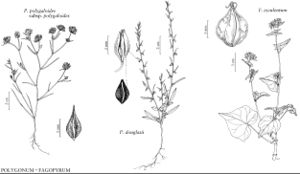Polygonum douglasii
Bull. Calif. Acad. Sci. 1: 125. 1885.
Herbs. Stems erect, green, simple or branched, not wiry, 5–80 cm, glabrous or sparsely papillose-scabridulous. Leaves uniformly distributed, articulated to ocreae, basal leaves caducous, distal leaves abruptly reduced to bracts; ocrea 6–12 mm, glabrous or minutely papillose-scabridulous, proximal part cylindric, distal part hyaline, lacerate; petiole 0.1–2 mm; blade 1-veined, not pleated, linear, narrow-oblong, or oblanceolate, 15–55 × 2–8 (–12) mm, margins revolute, smooth or papillose-denticulate; apex acute to mucronate. Inflorescences axillary and terminal, spikelike, elongate; cymes widely spaced along branches, 2–4-flowered. Pedicels mostly exserted from ocreae, reflexed, 2–6 mm. Flowers closed; perianth 3–4.5 mm; tube 20–28% of perianth length; tepals overlapping, green to tannish with white or pink margins, petaloid, oblong, cucullate, navicular, apex rounded; midveins usually branched, rarely unbranched; stamens 8. Achenes enclosed in perianth, black, elliptic or oblong to ovate, 3–4 (–4.5) mm, faces subequal, shiny or dull, smooth or minutely striate-tubercled.
Phenology: Flowering Jun–Oct.
Habitat: Dry, often disturbed places, rock outcrops, sandy ground
Elevation: 300-3000 m
Distribution

Alta., B.C., Man., Ont., Que., Sask., Yukon, Ariz., Calif., Colo., Idaho, Iowa, Mich., Minn., Mont., Nebr., Nev., N.H., N.Mex., N.Y., Oreg., S.Dak., Utah, Vt., Va., Wash., Wyo.
Discussion
Five taxa that have been included in Polygonum douglasii (E. Murray 1982; J. C. Hickman 1984; J. T. Kartesz and K. N. Gandhi 1990) are treated here as distinct species: P. austiniae, P. majus, P. nuttallii, P. sawatchense, and P. spergulariiforme. Hickman noted extensive intergradation and numerous intermediate specimens among those sympatric elements, but qualitative or quantitative characters allow reliable discrimination in most cases (M. Costea and F. J. Tardif 2005), and species are here circumscribed similar to C. L. Hitchcock (1964).
Greene described var. latifolium as having leaf blades and achenes broader than those of var. douglasii. C. L. Hitchcock (1964) recognized the former, but the characters used to distinguish it appear to vary continuously, and reliable separation is not possible.
Selected References
None.
Lower Taxa
"/2" is not declared as a valid unit of measurement for this property.
